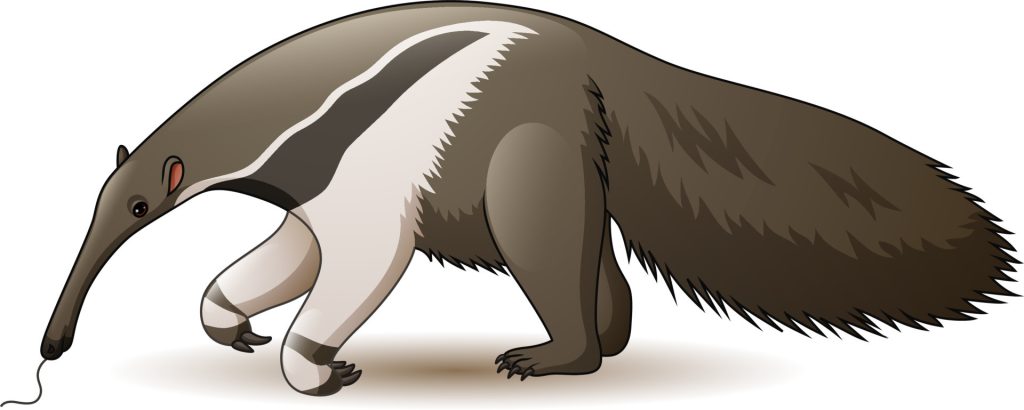Have you ever heard of an animal that is specially designed to eat insects? Meet the incredible creature called the anteater! With its unique features and specialized diet, the anteater has captured the curiosity of nature enthusiasts around the world. In this article, we’ll dive into the intriguing world of anteaters, exploring their physical characteristics, habitat, feeding habits, behavior, and more. So, let’s embark on a journey of discovery and unravel the mysteries of these fascinating insectivorous mammals.
What is an Anteater?

Anteaters are mammals known for their long snouts and tongues, which they use to feed on ants, termites, and other small insects. Belonging to the order Pilosa, anteaters are native to Central and South America. They are part of the superorder Xenarthra, which also includes sloths and armadillos. There are four recognized species of anteaters: the giant anteater, the silky anteater, the northern tamandua, and the southern tamandua.
Physical Characteristics of Anteaters
Anteaters have several distinctive physical features that make them well-suited for their specialized diet. One of their most notable characteristics is their long, tubular snout, which houses a slender tongue. The tongue can extend up to two feet in length and is covered in sticky saliva, allowing the anteater to capture insects with ease. Their snouts also serve as a powerful tool for breaking open termite mounds and ant nests.
Anteaters have sharp, curved claws that are adapted for digging and ripping apart insect nests. These claws are non-retractable and can grow up to four inches long, providing the anteater with the necessary tools for foraging. Additionally, their bodies are covered in coarse hair, which acts as protection against bites from insects.
Types of Anteaters
- 3.1 Giant Anteater
The giant anteater (Myrmecophaga tridactyla) is the largest species of anteater, measuring around six to seven feet in length, including the tail. It has a distinct black and white coloration on its long, bushy tail and a prominent stripe pattern on its body. The giant anteater has a specialized tongue that can flick in and out rapidly, capturing thousands of insects in a matter of minutes.
- 3.2 Silky Anteater
The silky anteater (Cyclopes didactylus) is the smallest species of anteater, reaching a length of just five to six inches. Despite its small size, it has a prehensile tail that allows it to hang from branches and reach for insects. The silky anteater has a dense, silky fur coat that serves as camouflage among the trees.
- 3.3 Northern and Southern Tamandua
The northern tamandua (Tamandua mexicana) and the southern tamandua (Tamandua tetradactyla) are medium-sized anteaters known for their distinctive color patterns. They have a yellowish-white or golden coat with a black “vest” pattern on their backs. Tamanduas have a prehens
ile tail and are excellent climbers, often spending a significant amount of time in trees.
Habitat and Distribution
Anteaters inhabit various habitats throughout Central and South America, including forests, grasslands, and savannas. They are found in countries such as Brazil, Argentina, Venezuela, and Costa Rica. The specific habitat requirements may vary among species, with some preferring dense forests while others adapt well to open grasslands.
Anteater Diet and Feeding Habits
Anteaters are highly specialized insectivores, and their diet primarily consists of ants and termites. They use their keen sense of smell to locate insect colonies, and once found, they use their powerful claws to break into the nests. The anteater then extends its long tongue into the nest, lapping up the insects with lightning speed. It can consume thousands of insects in a single day, making it an efficient predator of small invertebrates.
Adaptations for Feeding
The physical adaptations of anteaters are perfectly suited for their feeding habits. Their elongated snouts and tubular tongues allow them to reach deep into narrow insect tunnels, extracting their prey with precision. The sticky saliva on their tongues ensures that the insects adhere to it, making it easier for the anteaters to catch their prey.
Anteaters also have a specialized stomach that contains powerful acids capable of breaking down the exoskeletons of insects. This adaptation enables them to extract the maximum nutritional value from their food source.
Anteater Behavior and Reproduction
Anteaters are solitary animals and are mostly active during the night. They spend the majority of their time foraging for insects, using their sharp claws to tear through ant hills and termite mounds. When threatened, anteaters may defend themselves by using their sharp claws and powerful forelimbs.
In terms of reproduction, anteaters have a relatively long gestation period, which can last from six to eight months, depending on the species. Females give birth to a single offspring at a time, and the young anteaters cling to their mother’s back for protection and transportation.
Anteater Conservation Status
Several species of anteaters face conservation concerns due to habitat loss, illegal hunting, and the pet trade. The International Union for Conservation of Nature (IUCN) lists the giant anteater as vulnerable, while the silky anteater and tamandua species are classified as least concern. Efforts are being made to protect their natural habitats and raise awareness about the importance of conserving these unique creatures.
Anteaters in Popular Culture
Anteaters have also made their way into popular culture, becoming recognizable symbols in certain regions. The giant anteater is the national animal of Uruguay, and it features in the country’s coat of arms. Additionally, the iconic video game character “Sonic the Hedgehog” has a sidekick named “Knuckles the Echidna,” which is a fictional creature resembling an anteater.
FAQ
Are anteaters related to aardvarks?
Although anteaters and aardvarks share a similar ecological niche and both feed on ants and termites, they are not closely related. Anteaters belong to the order Pilosa, while aardvarks belong to the order Tubulidentata.
Can anteaters eat anything other than insects?
No, anteaters have highly specialized digestive systems adapted for consuming insects. They lack the necessary enzymes to digest other types of food effectively.
Are anteaters aggressive towards humans?
Anteaters are generally docile and shy creatures. However, if they feel threatened or cornered, they may defend themselves using their sharp claws and powerful limbs
How long can anteaters’ tongues extend?
An anteater’s tongue can extend up to two feet, allowing it to reach deep into insect nests and extract its prey.
Can anteaters swim?
Anteaters are not well-adapted for swimming. Their bodies are not buoyant, and their claws are better suited for digging rather than swimming.
Conclusion
In conclusion, anteaters are remarkable creatures with unique adaptations that make them exceptional insectivores. From their elongated snouts and tubular tongues to their sharp claws and specialized stomachs, every aspect of their anatomy is designed to excel in the pursuit of ants and termites. Although anteaters face conservation challenges, their captivating presence in popular culture and the ecological role they play as insect controllers highlight the significance of their existence. So, let’s appreciate and protect these fascinating insectivorous mammals for generations to come.

